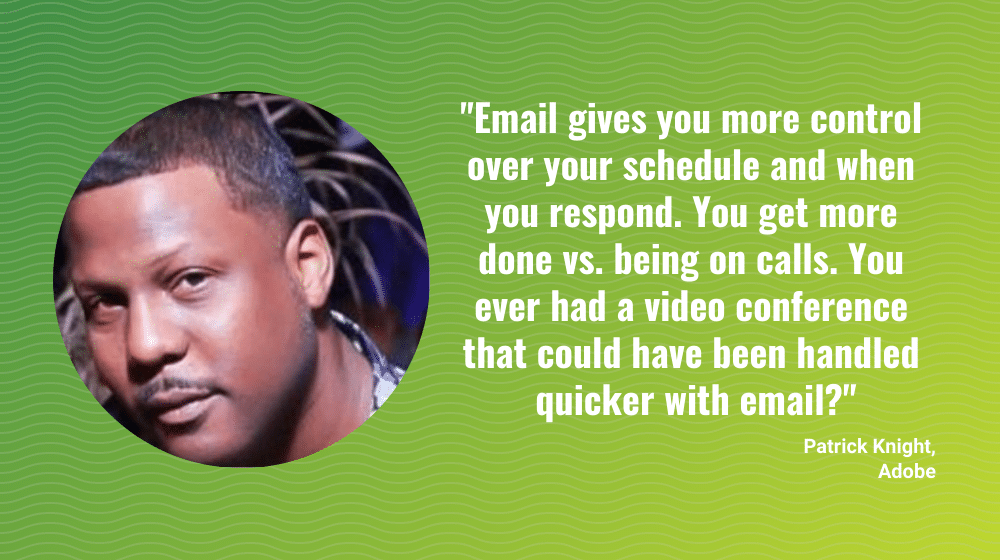
This week Adobe released a US-based study of one thousand currently employed people who usually work in an office setting to see how they are working during the COVID-19 pandemic. Among some of the findings include:
- Zoom fatigue is real – Only 33% of workers surveyed feel video conferencing is as productive as in-person meetings and another 34% say they’re starting to experience video conference fatigue. Instead, 78% of workers are using email to connect with colleagues, while 56% prefer making phone calls.
- Distance makes relationships grow stronger – 42% of workers feel they know their colleagues better now vs. when they were in the office. Of this group, a whopping 60% of parents admitted to feeling closer to fellow parent-colleagues as they bond over homeschooling their kids and adjusting to working life as stay-at-home-working-parent.
- Work/life balance is more critical than ever as workers decrease the number of minutes a day they check email by 10% (352 in 2019 down to 315 in 2020.) To keep the work/life separation, 53% of workers are waiting until they officially start the workday to check email (compared to 48% in 2019)
Interview with Patrick Knight of Adobe on Changing Work Behaviors
To dig in more to the study I had an opportunity to speak with Patrick Knight, Sr. Deliverability Consultant at Adobe, to get more takeaways and insights from the study. Click on the embedded SoundCloud player below to hear the full discussion.
Below is an edited transcript of a portion of our conversation.
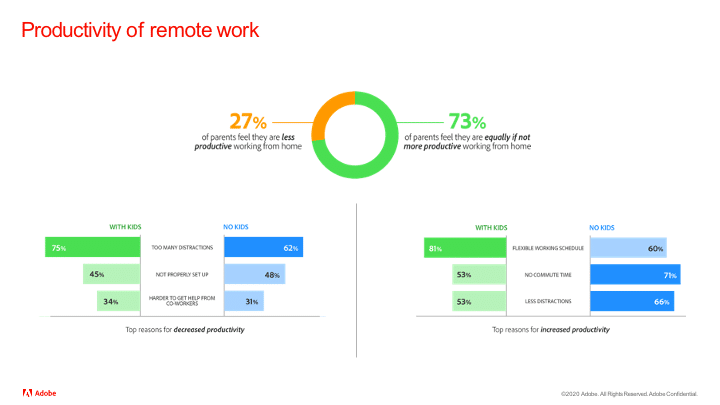
Small Business Trends: Interesting to see that so many people feel they are more productive working from home than they were going into the office.
Patrick Knight: You’re right, 73% of parents feel that they are equally, if not more productive working from home. And the reason for that is flexible schedules, right? It’s the primary reason. They feel that they can balance their life a little bit better. So for example, you can put the younger children down and maybe it’s nap time and then you can schedule your workload there. Or maybe after dinner, or maybe a little bit earlier before the kids wake up.
It forces you to have more control over things there. And when you’re in the office, you don’t have too much of that because of other things like commuting and so on and so forth. So yeah, having that flexibility is great. And then in turn, you can then have that time with your family and children and so on and so forth. So it’s really about that work-life balance that you can really take more advantage of versus being in an actual location.
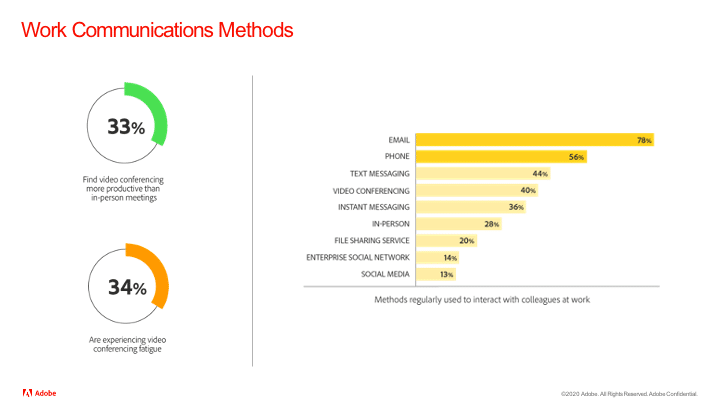
Small Business Trends: And even though we’re Zooming all the time now and using instant messaging apps, email and phone are by far the most popular communication channels for work.
Patrick Knight: Why is email so high? The first thing is that email is a communication channel that’s not an on-demand type of video conferencing. And just as a sidebar, there was a time where marketers felt that email was not going to be the communication channel anymore. But in the deliverability world, we knew that email would always stand strong. So they felt that SMS may take over instant messaging and other media.
However, we see that email is on top. And the reason why is because instant messaging and other forms of communication tend to be more interrupting, more intrusive. So if you think about that Slack conversation, that conversation may never end and you cannot be productive with that. It’s like the same for on-demand video conferencing.
With email, it gives you more control over your schedule, your time checking your email and when you respond. So this also allows you to get more done versus being on these calls. You ever had a video conference call or even an in-person conference that could have been handled with email? But because it’s so easy to push that button and say, “Well, I can get this person on my screen. They use it.”
So additionally or secondary, the phone communication also has that same effect. So this is the reason why you’re seeing email so high and you’re seeing the correlating information here between the video conferencing and email and why it’s a communication method that’s more preferred and you’re seeing it more.
Small Business Trends: Do you think if you did this survey a couple of months from now, that number for “Zoom Fatigue” would be significantly higher at this point?
Patrick Knight: Absolutely, because I think again, we’re going back to these… I think we already abuse meetings in general. Now we’re just going to take it to a whole other level. And then on top of that, we’re still stuck inside. So we’re going to have more of these meetings. And I would think that number would shoot up if not even maybe another 40% in the next few months because of where we are today.
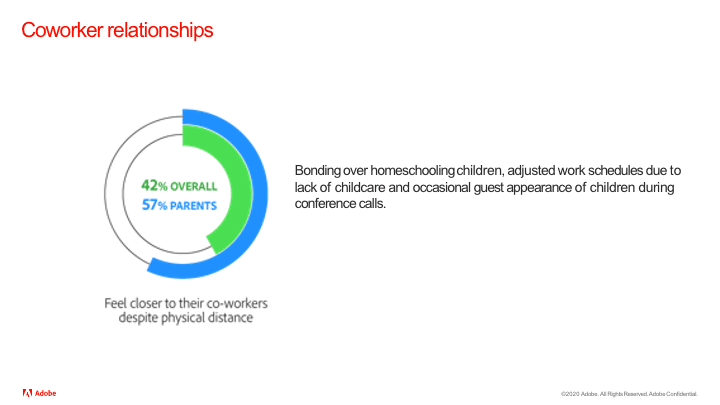
Small Business Trends: One of the more interesting findings was that doing web conferencing meetings seems to be making coworkers feel like they know each other even better than they did when they were doing face-to-face meetings.
Patrick Knight: Yeah, absolutely. I thought this was interesting as well. And this made perfect sense to me. So nearly half of American workers say they know their coworkers better than when they were in the office. Then nearly 60% of parents reported feeling closer to their colleagues as they bond over things such as homeschooling children, adjusting work schedules due to lack of childcare, even occasional guest appearances of those pets or children or someone’s running across the screen. Sometimes a cat may… I’ve seen it where, it was on a call with a client the other day, and their cat just came right on in and just started touching the screen and everything else.
And then you also see the background of your office because it gives you more of a understanding of who that person is. You see people every day at work. You hear about the children, you hear about pets, you hear about what their interests are, but seeing it, which is another means of sensory that is pretty powerful, sight, that brings that bond together. And that’s the reason why it’s actually not surprising to me to see the numbers and results that we have so far.
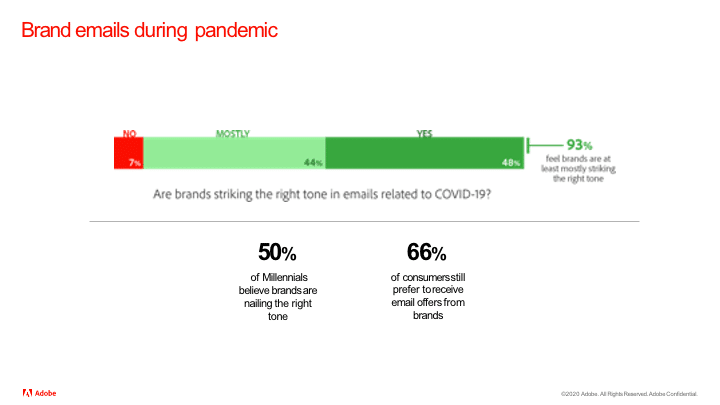
Small Business Trends: And maybe this helps to explain this a stat that says 93% of folks surveyed say they feel brands were striking the right tone with their email communications during the pandemic, because, quite honestly, when I was looking at this the first time around, I was like, “Are you kidding me? 93% feel like brands are hitting it out of the park on the messaging?” But you have a theory for why this is the case.
Patrick Knight: Absolutely. So, yeah, we can see clearly that 93% of consumers feel that most brands were striking the right tone with emails, especially when we talk about COVID and despite the increase of focus on COVID from brands related to safety. That was a large percentage of it, just COVID-related emails in general.
Brands understand that connection means everything when it comes to their consumers, especially through email. Because email is a… It’s a conversation. I always say that email is a two-way conversation. So if you’re just sending out information and you’re not really relating or targeting or creating really relevant content, email is pointless. So I think with COVID it was very relevant for everyone. So hence the reason why I think they are really sending out the right communication, we care, we understand and we’re here for you.
Now, what’s interesting is that 66% of those consumers, they still want the email offers. Thank you for telling me about COVID, thank you for understanding and now I want to engage more because of the fact that you care and we’re trapped at home. Everyone’s buying online. So they want to receive those offers from those brands and they want to understand exactly what those discounts look like. Because I can tell you right now, most of the companies that have an online presence, they’re doing amazing because of the fact everyone’s ordering something. I have to tell my wife, “Stop ordering from Amazon. Stop it!”
You just want to hit that button and literally every day somebody comes here. My doorbell rings and there’s a package and it’s just not my household. I’ve spoken to many. And because the brick and mortar is going away for right now, the email really is what drives traffic to a website. So if you get an email about an offer that is relevant and it’s engaging, then that’s going to just drive that customer to your website, where they’re going to purchase and purchase and purchase.
I can tell you, I have had countless conversations during even freelance, I did freelance Livability for a while, and every client that I would talk to, even now, engagement is important. Engagement drives something called email reputation. And so if your reputation is actually really good, your chances of you reaching the subscriber, it’s their inbox, not their spam folder, it’s a heightened situation there. So I absolutely agree that they should continue with the same enthusiasm, the same strategy, the same energy that they have now. And that, in itself, will drive the traffic and the revenue that they want.
Now, them going back to the old ways, I think that because they’re seeing such great responses, I think more and more people are going to understand why engagement matters, why reputation matters, why they need to keep sending those very well thought out emails versus the batch-and-blast method, which previously was the thing to do before COVID. So once we start seeing the results of things, this is the direction I think, or hope, people will take.
But that will be up to everyone else to see. I can tell you that there’s great learnings here, but it’s really going to depend on the individual. And just as a thought again with that, I recommend always engage. Whatever you’re doing now, continue because this is what’s going to keep your brand alive. This is what’s going to build the trust with a subscriber and your customers. This is what’s going to drive conversions and open rates. And that’s where the meat is. That’s exactly where you want to be.
CHECK OUT MORE:
This article, “Patrick Knight of Adobe: 57% of Parents Feel Closer to Coworkers Now Despite Working from Home” was first published on Small Business Trends